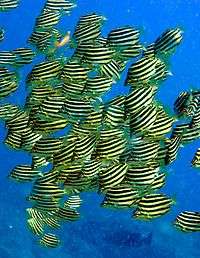Stripey
The stripey (Microcanthus strigatus), also known as the footballer or convict fish, is a species of ray-finned fish, a sea chub from the subfamily Microcanthinae which is part of the family Kyphosidae. It is native to the Pacific Ocean where it has a wide range. This species may be found in the aquarium trade. It is the only known member of its genus.
| Stripey | |
|---|---|
| Scientific classification | |
| Kingdom: | Animalia |
| Phylum: | Chordata |
| Class: | Actinopterygii |
| Order: | Perciformes |
| Family: | Kyphosidae |
| Subfamily: | Microcanthinae |
| Genus: | Microcanthus Swainson, 1839[2] |
| Species: | M. strigatus |
| Binomial name | |
| Microcanthus strigatus (G. Cuvier, 1831) | |
| Synonyms[3][4] | |
|
For Genus: For species:
| |

Description
The stripey has a deep, compressed body which has a rounded back, it has a distinctive pattern of oblique black and yellow, sometimes white, stripes. The stripes extend onto the dorsal and anal fins, and there is a black stripe which runs from the forehead to just to the rear of the eye.[5][6] The maximum total length is 16 centimetres (6.3 in).[3]
Distribution
The stripey is found in the Pacific Ocean where it has a disjunct distribution with a northern and a southern population. The northern population is found from Japan and Taiwan to Hawaii and the southern population is found along the southern coasts of Australia, around Lord Howe Island and off New Caledonia.[1] The Australian distribution runs from central Queensland to southern New South Wales, although it may extend as far as eastern Victoria and the north east of Tasmania. There is also a population in Western Australia which is found from Cape Leeuwin to Exmouth Gulf.[5]
Habitat and biology
The stripey occurs in coastal and lagoon reefs where during the day it forms dense schools which hide under ledges and in caves. It feeds on small crustaceans and algae.[3] Juvenile stripets are often seen in tidal pools while the adults may be seen around man-made structures such as jetties and harbour walls.[5] They may enter brackish water.[7]
Aquarium
Tye stripe is used in the aquarium trade but is regarded as rare.[8]
Taxonomy
The stripe was first formally described as Chaetodon strigatus by the French zoologist Georges Cuvier in 1831 with the type locality given as Nagasaki.[9] It is the only species in the genus Microcanthus[10] which was named by the English zoologist William John Swainson in 1839.[2]Some authorities have suggested that there may be as many of three species within the taxon currently knows as Microcanthus strigatus but this not widely accepted.[7]
References
- Carpenter, K.E. & Robertson, R. (2019). "Microcanthus strigatus". IUCN Red List of Threatened Species. 2019: e.T68383670A68400634. doi:10.2305/IUCN.UK.2019-2.RLTS.T68383670A68400634.en. Retrieved 30 April 2020.
- Eschmeyer, W. N.; R. Fricke & R. van der Laan (eds.). "Microcanthus". Catalog of Fishes. California Academy of Sciences. Retrieved 30 April 2020.
- Froese, Rainer and Pauly, Daniel, eds. (-2019). "Microcathus strigatus" in FishBase. December -2019 version.
- Eschmeyer, W. N.; R. Fricke & R. van der Laan (eds.). "Microcanthidae genera". Catalog of Fishes. California Academy of Sciences. Retrieved 30 April 2020.
- Bray, D.J. (2019). "Microcanthus strigatus". Fishes of Australia. Museums Victoria. Retrieved 30 Apr 2020.
- Mark McGrouther (14 January 2019). "Stripey, Microcanthus strigatus (Cuvier, 1831)". Australian Museum.
- "Stripey". Fish of the Month. Hawaiifishes.com. Retrieved 30 April 2020.
- "Write-Up Wednesday: Australian Stripey (Microcanthus strigatus)". Mr Saltwatertank. 2015. Retrieved 30 April 2020.
- Eschmeyer, W. N.; R. Fricke & R. van der Laan (eds.). "Chaetodon strigatus". Catalog of Fishes. California Academy of Sciences. Retrieved 30 April 2020.
- Froese, Rainer and Pauly, Daniel, eds. (2019). Species of Microcathus in FishBase. December 2019 version.
External links
- Photos of Stripey on Sealife Collection
